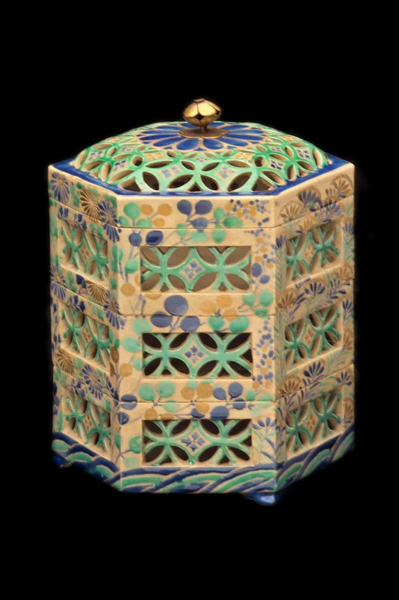
Unknown
Japanese
Hexagonal Tiered Box , 18th c. CE, early Edo period
Kyoto stoneware, Ko-kiyomizu type with overglaze enamels and gold, and gilt metal alloy knob
SBMA, Museum purchase with John and Peggy Maximus Fund
2006.70.1a-d
RESEARCH PAPER
During the Edo Period (1600-1869), Japan was unified under a military government, which took Edo (Tokyo) as its shogunal capital. Kyoto remained the capital as home of the imperial family and cultural center of Japan. Despite an often repressive military government, art flourished. The relative peace and prosperity of this period saw a rise in the middle class and emerging artist movements. This period also coincides with an expanded interest in 'tea culture'--the codified ceremony of preparing and serving tea. Tea bowls and plates for delicacies were desirable.
As early as the 8th century Kyoto was a center for ceramic production. A vein of finely textured clay, well suited for painted decoration, was a local natural resource. The demand from imperial and religious institutions provided impetus.
In the late 16th century, a truly distinctive Kyoto style of ceramics began to emerge. The catalysts were the tea ceremony and cultured and/or affluent patrons. These patrons influenced styles in tea ware from subtle designs to more decorative items for food serving.
Kyoto residents had a passion for Kabuki Theater—day long performances provided ample time for eating and drinking. The enjoyment of nature in a year long cycle of picnics, sake, and tea events required proper utensils. It is not surprising that Kyoto potters were often occupied with creating vessels for eating and drinking.
Kyoto ware or kyoyaki is essentially a stoneware (clay) based ceramic decorated with traditional Japanese designs, almost exclusively representational, in bright overglazed enamels. It is not limited to tea ceremony utensils; Kyoto ware includes food vessels, incense burners, flower vases, and inkstone boxes. Unusual and imaginative shapes and playful designs are frequent. Often artists reproduced clay designs 'borrowed' from nature--wood or bamboo. Our Hexagonal Tiered Box with Seven Jewels Openwork is a reflection of much that is characteristic of Kyoto ware.
Crafted in the early 18th century, our hexagonal tiered box exemplifies the characteristic interest in traditional Japanese decorative motifs. Chrysanthemums, wild carnations, and brush clover as well as grasses, cover the box surfaces. Use of seasonal motifs in general, and autumn in particular, illustrates the abiding interest in nature, which is a hallmark of Japanese art. The autumnal theme of our hexagonal tiered box leads one to imagine it filled with treats to enjoy on an evening excursion to observe the autumn moon.
The decorative motifs on our box were created by use of an overglaze technique. Overglaze enamels had been used for centuries in Japan on white porcelain, but their extensive use for decorating pottery became a distinctive feature of Kyoto ware.
The overglaze method used for our hexagonal box requires that an object be fired with a transparent glaze, and then decorated with colored glazes called enamels. The use of glazes was a very important feature of Kyoto ware. Frit (a purified glass) was mixed with natural materials to create colored enamel--red from iron oxide, green from copper oxide, and blue from cobalt. The object was then fired for a second time at a lower temperature to fuse the enamels to the object.
The use of a hexagonal shape reflects an interest in unusual shapes characteristic of Kyoto ware. The format provides interesting space for decoration and allows the openwork Seven Jewel motif to be shown to advantage; however, the hexagonal format and openware would have required considerable skill to achieve.
Our box is a three-tiered hexagonal nesting box with a lid. Careful construction would have been required to ensure each box was a proper fit. The box may have been constructed using a traditional slab method. Careful measurement would have been required to insure proper fit, equal thickness of the box wall, and allowance for shrinkage in drying and firing.
The openwork (literally open spaces) of the Seven Jewel pattern was cut into the box wall and lid when the clay was about 50% dry. After sketching out the pattern, the potter opened holes for the design in the box and finished the pattern with a very sharp knife.
The Seven Jewel motif can refer to seven stones regarded as precious or auspicious. Here it functions as an auspicious motif with interlocking circles and subordinate areas filled with a four-petal flower.
Kyoto ware reflects both the precision and imagination of the artisans of a unique city. A combination of mastery of a traditional art coupled with originality makes Kyoto ware of the Edo Period a treasure.
Prepared for the Docent Council of the Santa Barbara Museum of Art by Gwen Hatten Baker
April 9, 2009
SBMA CURATORIAL LABELS
This tiered box is an exceptional example of the high artistic expression and technical achievement of Kyoto ware. Reflecting the elegance and courtly taste of the arts of the region, Kyoto ware is distinguished by bright blue and green, lyrical plant imagery juxtaposed with abstract patterns on vessels of unusual shapes. The beautiful geometry of the openwork of interlocking circles, known as the “Seven Jewels” motif, provides a contrast to the delicately painted autumn grasses and flowers; both design elements are allusions to classical poetry that celebrated the beauty and evanescence of time.
SBMA Gallery Label 2012
